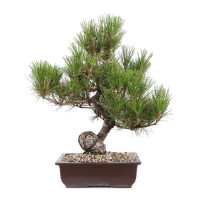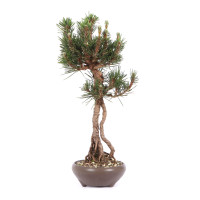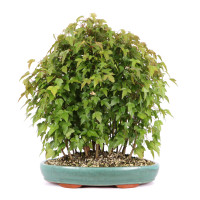- Order number: 1023-K-24-2418
- Height: 55 cm (incl. pot)
- Foliage: evergreen
- Bonsai Pot: ceramic pot
- Age: ca. 25 years
- Importjahr: 2024
- Origin: Japan
Pinus parviflora ‘Glauca‘ - Japanese White Pine 'Glauca'
General:
The white pine (Pinus parviflora) grows in the mountain forests of Japan. There it reaches a height of up to 25 meters. At the beginning the crown is conical and later rather flat and irregular, similar to the Scots pine we know. The needle-shaped leaves are evergreen and there are five in clusters. The needles have white stoma lines and are generally blue-green to blue-gray in color.
Care as a bonsai:
The Japanese pine has a very high status in Japan due to its symbolism (masculinity, strength, long life) and is perhaps the most popular bonsai of all. It is robust and offers many design options. As a bonsai they exude a lot of power due to their coarse character. On the other hand, the designed pine shows little change compared to deciduous trees and thus gives the viewer a lot of calm over the course of the year. A designed pine is basically very easy to care for. The new shoots (candles) are shortened or broken with the fingers in May and branches that are too dense are thinned out in late summer. In summer, a sunny location is very beneficial. Pine trees shouldn't be kept too wet. During long periods of rain, it is even advisable to put the plant under a roof. You can wire and design all year round. However, this should not coincide with the repotting at the beginning of September. In addition, the plant must ideally be frost-free after the design. A structurally stable, airy mixture is used for the substrate and attention is paid to the presence of mycorrhizal fungi. You can recognize the fungus by an even, fine and white coating that envelops the roots and, ideally, runs through the whole earth. Pine trees are very hardy. Even so, they should be protected from dry winds in winter. Bonsai seedlings from the white pine have not proven themselves in Central Europe or usually die after a certain time. We only offer refinements because the roots of the rootstock (e.g. Pinus thunbergii) are better adapted to our climate.
Special features of the variety:
The ‘Glauca‘ variety grows as a small, multifaceted tree and has clearly bluer needles than the wild species. This makes the plant very suitable for bonsai cultivation.










































